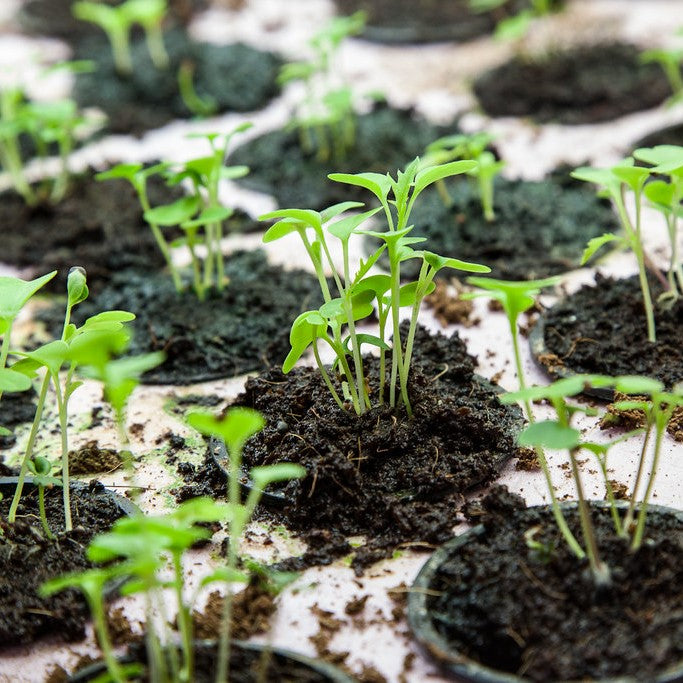How to Care for the Seedlings in Your Garden
•Posted on April 25 2019

Deciding to grow your own food is a major step and a larger commitment than many people realize.
Sowing a seed is probably the easiest part. It’s caring for the seedling afterward that may be the most challenging.
Keep reading to learn how to properly care for your seedlings so they grow into mature, productive plants.
What Are Seedlings?
A seedling is a young plant cultivated from a seed rather than a cutting. The first stage of seedling development begins with the germination of a seed.
As the seed is exposed to the correct amount of moisture, light, and heat, the plant will begin to form the root, the shoot, and the seed leaves.
Also known as the radicle, hypocotyl, and the cotyledons, respectively. These three parts are the first stage of a plant’s life cycle.
Can Seedlings Grow in Any Kind of Container?

One of the best things you can do for your seedlings is to start them off by planting them indoors.
Growing trays are a great go-to resource for this, but really, any container with adequate room for root growth and some drainage holes at the bottom will do the trick.
In fact, paper cups can be a perfect choice for seedlings as they're biodegradable, provide enough growing space, and are easy to create drainage holes in.
What Type of Soil Should I Use?
If you’re new to gardening, seed starting mix is a safe bet to ensure your seedlings’ healthy growth, though others may feel seed starting mix isn’t completely necessary.
The thing with starting mix is that it has a fine texture and is very low in nutrients compared to regular potting soil, allowing your seedlings’ roots to stretch out as far as they can into their growing container.
This ensures the seedlings maximize their root growth.
Additionally, seed starting mixes tend to be sterilized to prevent the bacteria that cause "damping off" (more on this below), from multiplying and killing your seedlings.
But ultimately, the choice to use seed starting mix, whether store-bought or homemade, is entirely up to you.
Transplanting Your Seedlings

Transplanting seedlings, removing them from their starter containers and planting them outdoors, is twofold: prepping them for transplant and actually planting them.
Seedlings shouldn't make their way to their permanent home until the weather is just right, this depends on what exactly it is that you're growing.
Planting them too early means they may succumb to the cold weather, and adversely, planting them too late in the year could mean that they're unable to stand the heat of the summer. Ideally, the dates around the last spring frost are the ideal time for transplanting your seedlings.
But this is why you want to prep your seedlings for outdoor life prior to transplanting and there are two ways to do so:
1. Thinning: when you keep the healthiest seedlings and remove the others by pulling them out of the soil.

Thinning your plants ensures they get adequate room to grow to absorb the necessary amounts of sunlight, moisture, and nutrients that they need to flourish without competing with other seedlings.
This also gives them enough air circulation to prevent moisture loving diseases from popping up.
2. Hardening off: the process of slowly introducing seedlings to the outside world.
Hardening plants increases their viability and the likelihood that they will flourish when they are planted outdoors.
You can do this by moving your seedlings outdoors two weeks prior to transplanting.
Every day you will leave them out for longer periods of time to get them used to the outside elements and prevent seedling stress that often causes young plants to go into shock and die.
What Diseases Are Seedlings Vulnerable to?

But seedling stress isn’t the only threat to the wellbeing of your seedlings. If anything, the main danger to seedlings is a disease known as damping off – a soil-borne disease caused by several different fungi resulting in seedling rot.
Damping off usually occurs when seedlings are planted into cold and wet soil. Although, it can also happen from excessive humidity or planting seedlings too deeply into the ground.
Unfortunately, if your plants are affected by damping off, there's nothing that can be done to save them. However, this is a relatively simple issue to avoid. Here are a few ways how:
- Plant seedlings in sterile potting mix rather than soil directly from your garden.
- Use clean pots or containers.
- Plants seeds so they can easily germinate.
- Don’t crowd seedlings.
- Water seedlings from the bottom by placing their container in a tray of water.
Do Seedlings Need to Be Fertilized?
When a seed first sprouts, it's not necessary to fertilize it. However, when a seed begins to show its second set of leaves, also known as its true leaves, then you should consider applying a natural water-soluble fertilizer, as this will help your plant get the best possible start.
Here at Greenway Biotech, we stock a variety of natural water-soluble fertilizers that are perfect to ensure the healthy growth of your seedlings. Check out our full range below.
Here’s to healthy, happy plants no matter what stage they’re in.
Related Posts:
Comments
0 Comments
Leave a Comment